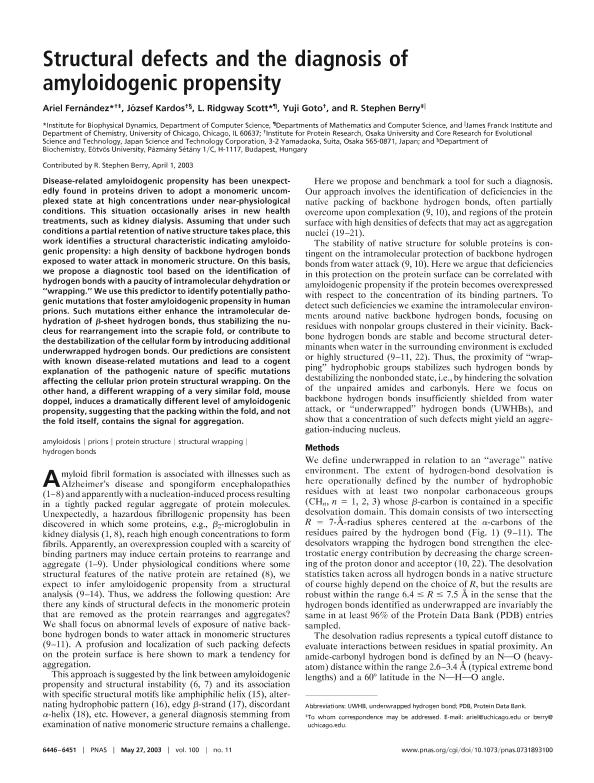Mostrar el registro sencillo del ítem
dc.contributor.author
Fernandez, Ariel

dc.contributor.author
Kardos, Jozsef
dc.contributor.author
Ridgway, Scott L.
dc.contributor.author
Goto, Yuji
dc.contributor.author
Berry, R. Stephen
dc.date.available
2020-02-10T17:56:48Z
dc.date.issued
2003-05-27
dc.identifier.citation
Fernandez, Ariel; Kardos, Jozsef; Ridgway, Scott L.; Goto, Yuji; Berry, R. Stephen; Structural defects and the diagnosis of amyloidogenic propensity; National Academy of Sciences; Proceedings of the National Academy of Sciences of The United States of America; 100; 11; 27-5-2003; 6446-6451
dc.identifier.issn
0027-8424
dc.identifier.uri
http://hdl.handle.net/11336/97078
dc.description.abstract
Disease-related amyloidogenic propensity has been unexpectedly found in proteins driven to adopt a monomeric uncomplexed state at high concentrations under near-physiological conditions. This situation occasionally arises in new health treatments, such as kidney dialysis. Assuming that under such conditions a partial retention of native structure takes place, this work identifies a structural characteristic indicating amyloidogenic propensity: a high density of backbone hydrogen bonds exposed to water attack in monomeric structure. On this basis, we propose a diagnostic tool based on the identification of hydrogen bonds with a paucity of intramolecular dehydration or "wrapping." We use this predictor to identify potentially pathogenic mutations that foster amyloidogenic propensity in human prions. Such mutations either enhance the intramolecular dehydration of β-sheet hydrogen bonds, thus stabilizing the nucleus for rearrangement into the scrapie fold, or contribute to the destabilization of the cellular form by introducing additional underwrapped hydrogen bonds. Our predictions are consistent with known disease-related mutations and lead to a cogent explanation of the pathogenic nature of specific mutations affecting the cellular prion protein structural wrapping. On the other hand, a different wrapping of a very similar fold, mouse doppel, induces a dramatically different level of amyloidogenic propensity, suggesting that the packing within the fold, and not the fold itself, contains the signal for aggregation.
dc.format
application/pdf
dc.language.iso
eng
dc.publisher
National Academy of Sciences

dc.rights
info:eu-repo/semantics/openAccess
dc.rights.uri
https://creativecommons.org/licenses/by-nc-sa/2.5/ar/
dc.subject
AMYLOIDOSIS
dc.subject
HYDROGEN BONDS
dc.subject
PRIONS
dc.subject
PROTEIN STRUCTURE
dc.subject
STRUCTURAL WRAPPING
dc.subject.classification
Biofísica

dc.subject.classification
Ciencias Biológicas

dc.subject.classification
CIENCIAS NATURALES Y EXACTAS

dc.title
Structural defects and the diagnosis of amyloidogenic propensity
dc.type
info:eu-repo/semantics/article
dc.type
info:ar-repo/semantics/artículo
dc.type
info:eu-repo/semantics/publishedVersion
dc.date.updated
2019-12-18T13:57:38Z
dc.journal.volume
100
dc.journal.number
11
dc.journal.pagination
6446-6451
dc.journal.pais
Estados Unidos

dc.description.fil
Fil: Fernandez, Ariel. Consejo Nacional de Investigaciones Científicas y Técnicas. Centro Científico Tecnológico Conicet - Bahía Blanca. Instituto de Química del Sur. Universidad Nacional del Sur. Departamento de Química. Instituto de Química del Sur; Argentina
dc.description.fil
Fil: Kardos, Jozsef. University of Chicago. Department of Computer Science. Institute for Biophysical Dynamics; Estados Unidos
dc.description.fil
Fil: Ridgway, Scott L.. University of Chicago. Department of Computer Science. Institute for Biophysical Dynamics; Estados Unidos
dc.description.fil
Fil: Goto, Yuji. Osaka University and Core Research for EvolutionalScience and Technology. Institute for Protein Research; Japón
dc.description.fil
Fil: Berry, R. Stephen. University of Chicago. Department of Computer Science. Institute for Biophysical Dynamics; Estados Unidos
dc.journal.title
Proceedings of the National Academy of Sciences of The United States of America

dc.relation.alternativeid
info:eu-repo/semantics/altIdentifier/url/https://www.pnas.org/content/100/11/6446
dc.relation.alternativeid
info:eu-repo/semantics/altIdentifier/doi/http://dx.doi.org/10.1073/pnas.0731893100
Archivos asociados
